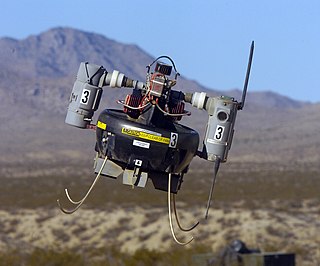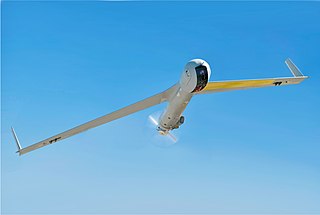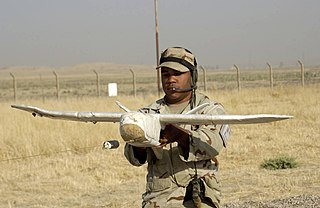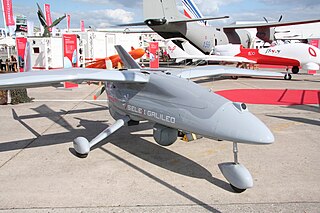
An unmanned aerial vehicle (UAV), commonly known as a drone, is an aircraft with no human pilot, crew, or passengers on board. UAVs were originally developed through the twentieth century for military missions too "dull, dirty or dangerous" for humans, and by the twenty-first, they had become essential assets to most militaries. As control technologies improved and costs fell, their use expanded to many non-military applications. These include aerial photography, area coverage, precision agriculture, forest fire monitoring, river monitoring, environmental monitoring, policing and surveillance, infrastructure inspections, smuggling, product deliveries, entertainment, and drone racing.

A micro air vehicle (MAV), or micro aerial vehicle, is a class of man-portable miniature UAVs whose size enables them to be used in low-altitude, close-in support operations. Modern MAVs can be as small as 5 centimeters - compare Nano Air Vehicle. Development is driven by commercial, research, government, and military organizations; with insect-sized aircraft reportedly expected in the future. The small craft allow remote observation of hazardous environments or of areas inaccessible to ground vehicles. Hobbyists have designed MAVs for applications such as aerial robotics contests and aerial photography. MAVs can offer autonomous modes of flight.

The Boeing Insitu ScanEagle is a small, long-endurance, low-altitude unmanned surveillance and reconnaissance aerial vehicle built by Insitu, a subsidiary of Boeing, and is used for reconnaissance. The ScanEagle was designed by Insitu based on the Insitu SeaScan, a commercial UAV that was intended for fish-spotting. The ScanEagle continues to receive improvements through upgrades and changes.

A miniature UAV, small UAV (SUAV), or drone is an unmanned aerial vehicle small enough to be man-portable. Smallest UAVs are called micro air vehicle.

The Lockheed Martin Desert Hawk is a miniature UAV used for base perimeter protection. It was designed by Lockheed Martin's Skunk Works for the United States Air Force Force Protection Airborne Surveillance System (FPASS) Program on a quick-reaction contract issued late in the winter of 2002, with the first system delivered in the early summer. It was designed quickly, because the program leveraged technology and design studies developed for the MicroStar MAVs. The program was run by Electronic Systems Center. In 2007, the U.S. Air Force FPASS office switched all of their UAV systems over to the RQ-11B Raven.

The TAI Anka is a family of unmanned aerial vehicles developed by Turkish Aerospace Industries primarily for the Turkish Air Force. Envisioned in the early 2000s for aerial surveillance and reconnaissance missions, Anka has evolved into a modular platform with synthetic-aperture radar, precise weapons and satellite communication.
The U.S. Department of Defense (DoD) classifies unmanned aerial systems (UAS) into "Groups" according to their size and capability, a joint system that replaced the service branches' separate categorization schemes in 2011.

The Prioria Robotics Maveric is a discontinued unmanned aerial vehicle (UAV) marketed as a high-performance, next-generation platform for small and miniature UAV operations. Maveric's bendable wings allow for the ability to store a fully assembled airframe in a 6-inch (150 mm) tube.

The IAI Searcher is a reconnaissance UAV developed in Israel in the 1980s. In the following decade, it replaced the IMI Mastiff and IAI Scout UAVs then in service with the Israeli Army.

The Falco is a tactical unmanned aerial vehicle (UAV) designed and produced by Selex ES. The UAV is designed to be a medium-altitude, medium-endurance surveillance platform capable of carrying a range of payloads, including several types of high-resolution sensors. A larger variant, the Falco EVO, is capable of carrying larger payloads is also available. Neither system is designed to carry weapons, The launch customer, Pakistan, reportedly wanted the Falco armed, a request that Italy rejected.

The Patroller is a French medium-altitude long-endurance unmanned aerial vehicle developed and manufactured by Safran Electronics & Defense. The airframe is based on the Stemme ASP S15 motor glider.

The Chengdu GJ-1, also known as Wing Loong 1, is a Medium-Altitude Long-Endurance (MALE) unmanned aerial vehicle (UAV), developed by the Chengdu Aircraft Industry Group in the People's Republic of China. Intended for use as a surveillance and aerial reconnaissance platform, the Pterodactyl I is capable of being fitted with air-to-surface weapons for use in an unmanned combat aerial vehicle (UCAV) role.
The Imperial Eagle is an Indian light-weight mini-unmanned aerial vehicle (UAV) developed by the Aeronautical Development Establishment, National Aerospace Laboratories and supported by private vendors. Its primary users will be the National Security Guard and the military services.
The NAL/ADE Golden Hawk is an unmanned Micro Air Vehicle (MAV) technology demonstrator developed jointly by Aeronautical Development Establishment (ADE) of DRDO and National Aerospace Laboratories (NAL) of CSIR. It based on basic design of Shashank Misra and is one of the airframe designs being pursued for " National Program on Micro Air Vehicles" (NP-MICAV)
ASN-209 UAV and its derivative are Chinese UAVs developed by Xi'an Aisheng Technology Group Co., Ltd (西安爱生技术集团公司)ASN Technology Group Co., Ltd (西安爱生技术集团公司), also known as Northwestern Polytechnical University UAV Research Institute or 365th Institute, established in 1984.
The Bayraktar UAV or Bayraktar UCAV is a family of unmanned aerial vehicles designed and manufactured by Turkish company Baykar. The UAVs were developed for the Turkish Armed Forces from 2004 until the present. Some models are designed for surveillance and reconnaissance only, others are capable of tactical ground-strike missions. Baykar is also developing drones to counter other aerial systems. The word bayraktar means flag-bearer in Turkish.

As of January 2014, the United States military operates a large number of unmanned aerial vehicles : 7,362 RQ-11 Ravens; 990 AeroVironment Wasp IIIs; 1,137 AeroVironment RQ-20 Pumas; 306 RQ-16 T-Hawk small UAS systems; 246 MQ-1 Predators; MQ-1C Gray Eagles; 126 MQ-9 Reapers; 491 RQ-7 Shadows; and 33 RQ-4 Global Hawk large systems.

The TAI Aksungur is an unmanned combat aerial vehicle (UCAV) built by Turkish Aerospace Industries (TAI) for the Turkish Armed Forces. Using existing technology from the TAI Anka series of drones, it is the manufacturer's largest drone with payload capacity for mission-specific equipment. It is intended to be used for long-term surveillance, signals intelligence, maritime patrol missions, or as an unmanned combat aerial vehicle. TAI planned to integrate weapon packages and put the Aksungur into production in early 2020. The first unit was delivered to the Turkish Naval Forces on 20 October 2021.

An unmanned surveillance and reconnaissance aerial vehicle, is an unarmed military UAV that is used for intelligence, surveillance, target acquisition, and reconnaissance (ISTAR). Unlike unmanned combat aerial vehicle (UCAV), this type of system is not designed to carry aircraft ordnance such as missiles, ATGMs, or bombs for drone strikes. The main purpose is to provide battlefield intelligence. Small sized short-range man-portable unmanned aerial vehicles are called miniature UAV also used for battlefield intelligence.















